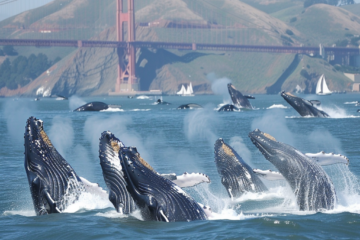Mountain Lion in Russian Hill + Big Cat Safety Guide
According to an eye witness who filmed the Mountain Lion, the big cat was cruising Russian Hill at 12:30 am on Tuesday.
At around 12:30 am I spotted a mountain lion roaming the streets of Russian Hill. I followed from inside my car and lost visual contact near intersection of Greenwich and Jones. Be safe when walking alone at night or when walking your pets. I reported the sighting to @SFPD pic.twitter.com/xlreghRSaJ
— Fernando Robles (@Ing_Fehr) June 16, 2020
It was later captured by a camera on the Embarcadero, by ABC7 News.
APOCALYPSE COMING? A mountain lion was spotted strolling along the Embarcadero and in SF's Russian Hill neighborhood overnight. https://t.co/7AzuNqvgFn pic.twitter.com/VygTHzqJ8u
— ABC7 News (@abc7newsbayarea) June 16, 2020
I spoke with Jonathan Young a wild life expert and ecologist for the Presidio Trust, and he told me that puma sightings in San Francisco are common and they happen almost every year now. “Pumas in San Francisco typically come from the Santa Cruz Mountain ranges that run all the way to Daly City…and coming up from the Crystal Springs reservoir”, Young continued, “CA Fish and Game has been notified and they will respond and dart (tranquilize) the animal if it gets cornered or ends up in somebody’s garage, but that is a rare occurrence…the animal is most likely trying to find her way out of the city as soon as possible.”
Jonathan also told me that Puma prey is primarily deer, and since there are no deer in San Francisco, and pumas are shy by nature, this Puma will most likely be trying to leave as soon as possible.
ABC7 asked Zara McDonald, a biologist with the Bay Area Puma Project about the animal sighting, Zara said, “It’s highly unusual behavior for mountain lions who are normally very avoidant and shy. One thing I noticed from the two videos is that this is a young sub-adult so it is not an adult lion. So most likely it came from the open space South of San Francisco where we have been tracking mountain lions and their movements for the last several years.”
Also, fun fact, no matter what you call this big cat, Mountain lion, puma, cougar, panther, it is still the same cat species throughout the Americas, ‘Puma concolor‘, it’s the largest of the small cat species, they are called many names but they are all the same cat species, and they do live all over the bay area.
Now, in case you are wondering what to do if you run into the ‘San Francisco Puma’, here are the guidelines to dealing with Mountain lions/Pumas/Cougars from the National Parks Service people. My favorite bit of advice is ‘cougars can leap up to 40 feet horizontally and 20 feet vertically’ & ‘Never run past or from a cougar. This may trigger their instinct to chase. Make eye contact.’ The 2nd part of that advice is the exact opposite of what you should do if you trying to avoid a human cougar on Russian Hill.
BIG CAT SAFETY GUIDE:

via nps: Encounters with cougars are rare. But if you live, work or recreate in cougar habitat, there are
things you can do to enhance your safety and that of friends and family.
1. When it comes to personal safety, always be aware of your surroundings, wherever you are;
conduct yourself and attend to children and dependents accordingly.
2. If you encounter a cougar, make yourself appear larger, more aggressive. Open your jacket,
raise your arms, and throw stones, branches, etc., without turning away. Wave raised arms
slowly, and speak slowly, firmly, loudly to disrupt and discourage predatory behavior
3. Never run past or from a cougar. This may trigger their instinct to chase. Make eye contact.
Stand your ground. Pick up small children without, if possible, turning away or bending
over.
4. Never bend over or crouch down. Doing so causes humans to resemble four-legged prey
animals. Crouching down or bending over also makes the neck and back of the head
vulnerable.
5. Try to remain standing to protect head and neck and, if attacked, fight back with whatever is
at hand (without turning your back)—people have utilized rocks, jackets, garden tools, tree
branches, and even bare hands to turn away cougars.
6. Don’t approach a cougar. Most cougars want to avoid humans. Give a cougar the time and
space to steer clear of you.
7. Supervise children, especially outdoors between dusk and dawn. Educate them about
cougars and other wildlife they might encounter.
8. Always hike, backpack, and camp in wild areas with a companion.
9. Don’t feed wildlife. Don’t leave food outside. Both may attract cougars by attracting their
natural prey.
10. Keep pets secure. Roaming pets are easy prey for cougars.
Mountain Lion Facts

Puma stats:
Height: 1.8 to 2.4 feet
Length: Males-3 to 6.5 feet
Females-3 to 5.5 feet
Weight: Males-125 to 220 pounds
Females-75 to 140 pounds
Habitat: Usually remote 25 to 100+ square miles “home range” in areas of forest,
swamp, grassland, desert and scrubs with, caves, or groups of rocks.
Diet: Squirrels, beavers, raccoons, coyotes, rabbits, birds, opossums, cattle, deer,
pig, porcupine, elk, or moose. (Mostly, eat animals with hooves.)
Mountain Lions can live in the wild for 20 years.
Can leap up to 40 horizontally and 20 feet vertically.
The mountain lion has a tan-colored coat, much like the African lion. The most
recognizable feature of the cougar is its long and heavy tail, which measures
almost two-thirds the length of the head and body.
Females usually breed at 2.5 years and commonly have 2 or 3 kittens (or cubs).
Newborn kittens weigh about one pound, measure about a foot in length and have
dark spots on their coats. Within 8 to 12 months these spots will fade. The kittens
are weaned at 2 months and are soon accompanying their mother around the home
area. The mother raises her young alone and trains them how to hunt. The kittens
stay with her from 18 to 24 months, and then disperse to find their own home
areas.










